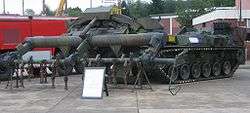Keiler (mine flail)
Keiler mine flail (German: Minenräumpanzer Keiler, 'tusker') is a mine-clearing vehicle developed by Rheinmetall in Germany to meet German Army requirements. It is a conversion of the M48 Patton medium tank chassis in combination with a German MTU MB 871 Ka 501 liquid-cooled turbocharged Diesel engine. The main role of the Keiler vehicle is clear a lane through minefields to let soldiers and vehicles pass safely.[1] A deployable mine flail system has been fixed to the front of the vehicle, being used to clear both anti-tank and anti-personnel mines. 24 Vehicles of this kind were produced between 1997-1998 for the German Army.[2]
| Keiler | |
|---|---|
 A Keiler, displayed with its mine flail deployed (2005) | |
| Type | Mine flail |
| Place of origin | Germany |
| Specifications | |
| Mass | 53 tonnes (52 long tons) |
| Length | 10.7 m (35 ft 1 in) |
| Width | 6.35 m (20 ft 10 in) |
| Height | 3.76 m (12 ft 4 in) |
| Crew | 2 |
| Engine | MTU MB 871 Ka 501 986 hp |
| Suspension | torsion-bar |
Operational range | 600 km (370 mi) |
| Maximum speed | 50 km/h (31 mph) |
Design
Keiler is built on the M48 Patton medium tank hull. Developers removed the turret of the Patton and fitted the vehicle with a heavy-duty rotor-powered mine flail, a rapidly rotating cylinder mounted between two arms in front of the vehicle consisting of two shafts with 24 chains terminating in large metal "feet".[3] In traveling mode the mine flail folds over the vehicle.
In common with other mine flails, the spinning cylinder swings the chains around, bringing the feet into contact with the ground, thus simulating the force exerted by a person or vehicle passing over the ground. If a flail strikes the ground above a buried mine, the impact will cause the mine to safely detonate. The vehicle can clear a lane 4.7 metres (15 ft) wide and 120 metres (390 ft) long in 10 minutes. An automatic system fixed on the rear of the hull marks the cleared lane.
The Keiler has no defensive weapons except its smoke grenade dischargers. The vehicle is operated by a crew of two (commander and driver).
Propulsion
Original engine of the M48 Patton has been replaced with a more powerful, German MTU MB 871 Ka 501 liquid-cooled turbocharged Diesel engine. This develops 986 horsepower (735 kW) in traveling mode, and 1,092 horsepower (814 kW) when driving the mine flail. A Renk HSWL 284 M transmission was fitted. The Keiler uses the same Torsion bar suspension as the M48 Patton tank, and has 6 wheels on each side.[2]
References
- "Keiler mine-clearing tank". rheinmetall-defence.
- "keiler". military-today.com.
- "The German M48A2 Keiler Engineering Vehicle". tanknutdave.com.